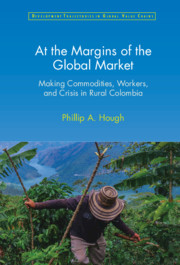Book contents
- At the Margins of the Global Market
- Development Trajectories in Global Value Chains
- At the Margins of the Global Market
- Copyright page
- Contents
- Figures and Tables
- Acknowledgments
- Introduction
- 1 Toward a Sociology of Labor and Development at the Margins of the Market
- Case Study #1 The Rise and Fall of Hegemony in the Coffee Regime of Viejo Caldas
- Case Study #2 Despotism and Crisis in the Banana Regime of Urabá
- Case Study #3 The Rise and Fall of FARC Counter-Hegemony in the Coca Regime of Caquetá
- 6 From Despotism to Counter-Hegemony in the Caguán
- 7 An Uncertain Future in the Caguán and Beyond
- Conclusion
- Appendix
- References
- Index
6 - From Despotism to Counter-Hegemony in the Caguán
from Case Study #3 - The Rise and Fall of FARC Counter-Hegemony in the Coca Regime of Caquetá
Published online by Cambridge University Press: 07 January 2022
- At the Margins of the Global Market
- Development Trajectories in Global Value Chains
- At the Margins of the Global Market
- Copyright page
- Contents
- Figures and Tables
- Acknowledgments
- Introduction
- 1 Toward a Sociology of Labor and Development at the Margins of the Market
- Case Study #1 The Rise and Fall of Hegemony in the Coffee Regime of Viejo Caldas
- Case Study #2 Despotism and Crisis in the Banana Regime of Urabá
- Case Study #3 The Rise and Fall of FARC Counter-Hegemony in the Coca Regime of Caquetá
- 6 From Despotism to Counter-Hegemony in the Caguán
- 7 An Uncertain Future in the Caguán and Beyond
- Conclusion
- Appendix
- References
- Index
Summary
This chapter begins with an analysis of the Colombian state’s efforts to transform the Caguán frontier region of Caquetá into a site of land colonization, settlement, and agrarian development in the 1960s. It demonstrates that these state-directed agrarian development initiatives lacked the political and economic support of Colombian elites, which resulted in the transformation of the region into a site of large-scale cattle ranching under the despotic rule of Colombia’s cattle rancher association, Fedegán. It then shows how the movement of the FARC guerrillas into the region, followed by their involvement in taxing and regulating the region’s emerging coca economy, helped generated a counter-hegemonic coca-producing labor regime that was effective in protecting local migrants from the displacement and marginalization they had experienced under the auspices of Fedegán. It ends with a discussion of the similarities and differences between the FARC’s counter-hegemonic regulatory interventions in the coca regime with Fedecafé’s hegemonic interventions in the coffee regime.
Keywords
- Type
- Chapter
- Information
- At the Margins of the Global MarketMaking Commodities, Workers, and Crisis in Rural Colombia, pp. 213 - 249Publisher: Cambridge University PressPrint publication year: 2022

